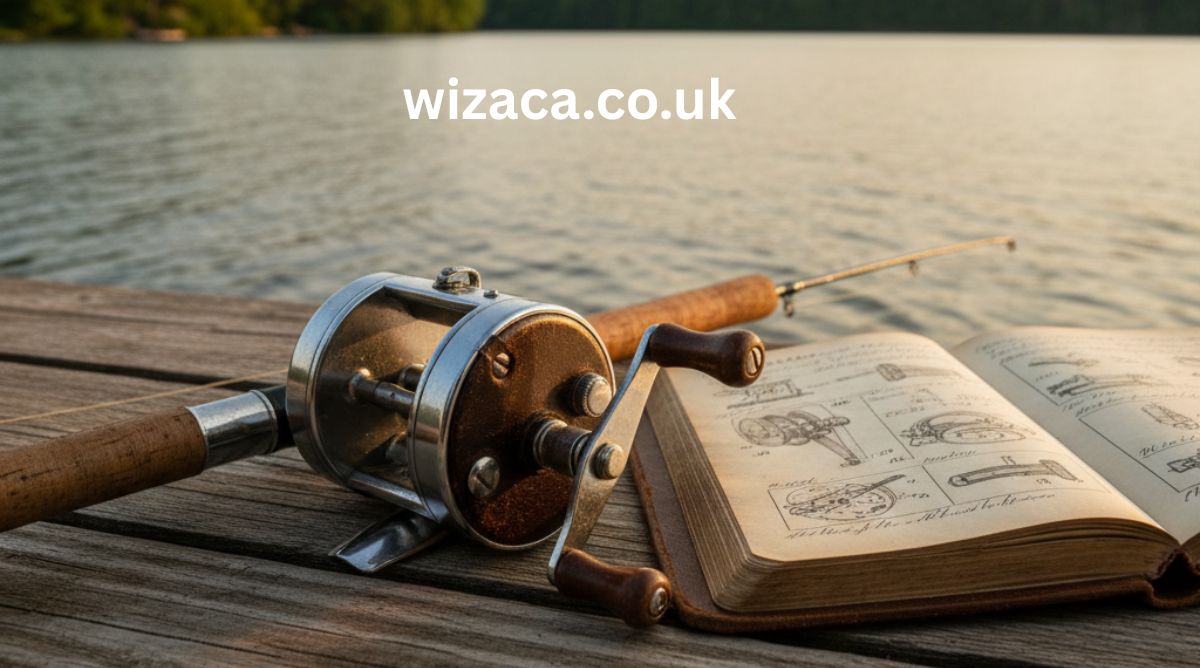The Zebco 404 is one of the most famous spincast reels in the history of fishing. Known for its toughness, simplicity, and affordable price, the Zebco 404 has served millions of anglers for decades. While most people know the 404 as a dependable reel, some vintage versions came with a fascinating feature known as the “leather anti-reverse.”
This article explores the complete history, design, and function of the Zebco 404, focusing on the early models that featured the unique leather anti-reverse system. We’ll also discuss how this mechanism worked, why leather was used, and how the 404 evolved into the modern reels available today.
1. History of the Zebco Brand
The story of the Zebco 404 begins with the company that created it — Zebco, short for Zero Hour Bomb Company. Founded in Tulsa, Oklahoma, in 1949, Zebco was originally a manufacturer of electric time bombs for oil drilling. The company’s transformation into a fishing tackle icon started when a watchmaker named R.D. Hull developed a new type of fishing reel that solved one of the biggest problems in casting reels — backlash.
Hull’s invention was the world’s first spincast reel, which used a closed-face design to prevent tangling. Zebco launched this innovation as the Zebco Model 33, and it changed fishing forever.
👉 Zebco – Wikipedia
👉 Fishing reel – Wikipedia
Over time, Zebco expanded its product line to include simpler and more affordable reels for beginners. One of these was the Zebco 404, designed for heavier fishing and bigger fish but still easy enough for anyone to use.
2. Introduction of the Zebco 404
The Zebco 404 was first introduced in the early 1960s as a larger and stronger version of the popular Zebco 202. It was marketed as a “heavy-duty” spincast reel, ideal for anglers who wanted to target larger species like catfish, bass, or carp without using complex baitcasting or spinning reels.
Key early features of the Zebco 404 included:
- Durable all-metal construction
- A fixed spool covered by a cone-shaped front cover
- Large line capacity (usually spooled with 15-pound monofilament)
- Adjustable drag system
- Simple push-button casting
- Anti-reverse mechanism (in some versions using leather components)
These features made the Zebco 404 a reliable and simple reel for all-purpose fishing. It also became one of Zebco’s longest-running models, still being produced today with updated materials and technology.
3. Understanding Spincast Reels
Before diving into the specifics of the 404’s leather anti-reverse, it’s important to understand what makes a spincast reel unique.
A spincast reel combines elements of both spinning and baitcasting reels. The main difference is its closed face, which hides the spool behind a metal or plastic cone. The line exits through a small hole at the front when you press the casting button.
Advantages of spincast reels include:
- Virtually no backlash
- Simple push-button operation
- Great for beginners
- Affordable and easy to maintain
The Zebco 404 became famous for all these reasons. It’s often the reel that kids and beginners start with — and many anglers never outgrow it.
4. What Is the Anti-Reverse Mechanism?
In fishing reels, the anti-reverse system prevents the handle from spinning backward when a fish pulls on the line. Without anti-reverse, the handle could rotate in reverse and release tension, allowing the fish to escape.
Anti-reverse systems generally come in two forms:
- Mechanical pawl system – A small lever or gear tooth locks into place when the handle moves backward.
- Roller bearing system – Found in modern reels, this uses a one-way bearing to stop reverse movement smoothly.
👉 Bearing (mechanical) – Wikipedia
The Zebco 404 used a simple mechanical anti-reverse, and in its earliest models, this mechanism sometimes included a leather pad or washer that acted as a friction material to prevent backward movement.
5. The Leather Anti-Reverse: How It Worked
The so-called “leather anti-reverse” refers to a unique internal setup found in some early Zebco 404 reels (and a few related models). In these reels, a small leather piece — often shaped like a washer or pad — was used as part of the anti-reverse assembly.
Here’s how it worked:
- The leather pad acted as a friction surface between a metal pawl and gear.
- When the angler turned the handle forward, the leather compressed slightly, allowing smooth motion.
- When the handle tried to move backward (from fish pressure), the leather’s frictional grip and the pawl’s shape locked the handle, stopping reverse movement.
Leather was chosen because it was:
- Readily available
- Durable enough to withstand pressure
- Quiet in operation (less metallic noise)
- Flexible and self-lubricating when oiled
This design was clever for its time but eventually replaced by metal or synthetic anti-reverse systems, which were more durable and less affected by moisture.
6. Why Leather Was Used in Early Reels
In the early days of fishing reel production (1950s–1960s), materials like nylon, Delrin, and Teflon weren’t yet widespread or affordable. Manufacturers often used leather, felt, and cork as friction materials in clutches, drags, and brakes.
Leather offered excellent friction characteristics, especially when treated with oil or grease. It was common in many mechanical applications — from old automobile brakes to camera shutters and even early fishing reel drags.
However, leather had two main drawbacks:
- It could absorb water and swell, changing its performance.
- It would wear out over time, especially with repeated stress.
As synthetic materials improved, manufacturers like Zebco phased out leather components in favor of plastic, metal, or fiber pawls, which were more consistent and water-resistant.
7. Identifying a Leather Anti-Reverse Zebco 404
Collectors and restorers often look for early Zebco 404 reels with the leather anti-reverse setup. To identify one:
- Check the reel’s age.
Most leather systems were used in early production models from the 1960s–1970s. Look for reels stamped “Made in USA” with metal bodies and early logo designs. - Disassemble carefully.
Remove the side plate and examine the anti-reverse area behind the main gear. - Look for a leather washer or pad.
It may appear dark brown, stiff, and slightly oily. It might also be compressed or cracked if it’s original. - Confirm the pawl system.
Leather anti-reverse reels usually have a simple metal pawl that presses against the main gear with the leather acting as a cushion or friction plate.
Collectors prize these reels because they showcase an early, transitional engineering design before Zebco fully standardized its parts.
8. Maintenance Tips for Leather Anti-Reverse Models
If you own or restore a Zebco 404 with a leather anti-reverse, follow these care tips:
- Clean gently. Use a soft cloth and light oil (like sewing machine oil). Avoid harsh solvents that can dry or damage leather.
- Condition the leather. If it’s dry, apply a tiny amount of leather conditioner to preserve flexibility.
- Keep it dry. Store the reel in a cool, dry place. Moisture can cause leather to rot.
- Don’t over-oil. Excess oil attracts dust and weakens friction.
- Use for display or light fishing only. Vintage leather systems aren’t as strong as modern anti-reverse bearings.
Many restorers choose to replace the leather with a synthetic washer or metal spring, but collectors often prefer keeping it original.
9. The Evolution of the Zebco 404
Over the decades, the Zebco 404 went through many updates:
1960s–1970s: The Classic Era
- Metal body and cone
- Leather or metal anti-reverse systems
- Simple drag
- Made in the USA
1980s–1990s: The Plastic Era
- Switch to lighter plastic components
- Updated design for mass production
- More consistent anti-reverse systems
- Made both in the USA and overseas
2000s–Present: The Modern Era
- Rebranded as a “Heavy-Duty Spincast Reel”
- Upgraded QuickSet™ anti-reverse (metal pawl)
- Stainless steel pickup pins
- Reinforced gears and smoother drag system
- Pre-spooled with 15-lb Zebco line
Even though modern 404s no longer use leather, they carry the same DNA — simple, tough, and beginner-friendly.
10. Collector Value and Legacy
While the Zebco 404 isn’t a rare collector’s item in general, specific early versions with the leather anti-reverse have become sought-after. Their value depends on:
- Condition (working, original, minimal rust)
- Age and markings
- Presence of the original leather piece
- Country of manufacture (USA models are prized)
Collectors often buy these reels not for fishing but for display or nostalgia. They represent a time when American engineering emphasized practicality, simplicity, and durability.
11. Why the Zebco 404 Still Matters Today
Even after more than half a century, the Zebco 404 continues to be sold and used by millions of anglers worldwide. Its design reflects the spirit of accessible fishing — anyone can cast it, anyone can fix it, and anyone can enjoy it.
The leather anti-reverse is a small but meaningful chapter in this reel’s history. It reminds us that fishing technology evolved not just through high-tech innovation but also through clever use of humble materials like leather.
12. Conclusion
The Zebco 404 with leather anti-reverse is more than just a fishing reel — it’s a mechanical time capsule. It bridges the gap between early hand-crafted engineering and modern mass production. The use of leather in its anti-reverse system shows how creativity and resourcefulness shaped the fishing gear of the 20th century.
For collectors, restoring or owning one of these vintage 404s is a way to connect with the history of fishing and appreciate how far technology has come. And for anglers, it’s a reminder that sometimes, the simplest tools catch the best fish.






